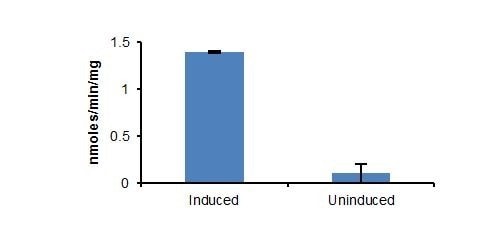Caspase-3 Activity Assay Kit (Fluorometric) (ab252897)
Key features and details
- Detection method: Fluorescent
- Platform: Microplate
- Sample type: Adherent cells, Suspension cells
- Sensitivity: 11.25 mU/well
Overview
-
Product name
Caspase-3 Activity Assay Kit (Fluorometric)
See all Caspase-3 kits -
Detection method
Fluorescent -
Sample type
Adherent cells, Suspension cells -
Sensitivity
11.25 mU/well -
Product overview
Caspase-3 Activity Assay Kit (Fluorometric) (ab252897) allows the detection and quantification of Caspase-3 activity by using a synthetic substrate DEVD-AFC (AFC: 7- amino-4-trifluoromethyl coumarin), which upon cleavage by Caspase-3 will emit a strong, stable fluorometric signal (Ex/Em= 400/505 nm). The assay is sensitive, fast and allows the high-throughput quantification of Caspase-3 activity in cell lysate or adherent cells. It can be used to evaluate induction of apoptosis and/or evaluation of apoptosis inhibitors. As little as 11.25 mU of activity per well and less than 500 apoptotic cells can be detected.
-
Platform
Microplate
Properties
-
Storage instructions
Store at -20°C. Please refer to protocols. -
Components 100 tests Ac-DEVD-AFC (1 mM) 1 x 500µl AFC Standard (1 mM) 1 x 100µl Caspase 2X Reaction Buffer 1 x 20ml Caspase Cell Lysis Buffer 1 x 100ml Caspase-3 (Positive Control) 1 vial DTT (1 M) 1 x 1ml Staurosporine (1 mM) 1 x 200µl -
Research areas
-
Function
Involved in the activation cascade of caspases responsible for apoptosis execution. At the onset of apoptosis it proteolytically cleaves poly(ADP-ribose) polymerase (PARP) at a '216-Asp-
-Gly-217' bond. Cleaves and activates sterol regulatory element binding proteins (SREBPs) between the basic helix-loop-helix leucine zipper domain and the membrane attachment domain. Cleaves and activates caspase-6, -7 and -9. Involved in the cleavage of huntingtin. -
Tissue specificity
Highly expressed in lung, spleen, heart, liver and kidney. Moderate levels in brain and skeletal muscle, and low in testis. Also found in many cell lines, highest expression in cells of the immune system. -
Sequence similarities
Belongs to the peptidase C14A family. -
Post-translational
modificationsCleavage by granzyme B, caspase-6, caspase-8 and caspase-10 generates the two active subunits. Additional processing of the propeptides is likely due to the autocatalytic activity of the activated protease. Active heterodimers between the small subunit of caspase-7 protease and the large subunit of caspase-3 also occur and vice versa.
S-nitrosylated on its catalytic site cysteine in unstimulated human cell lines and denitrosylated upon activation of the Fas apoptotic pathway, associated with an increase in intracellular caspase activity. Fas therefore activates caspase-3 not only by inducing the cleavage of the caspase zymogen to its active subunits, but also by stimulating the denitrosylation of its active site thiol. -
Cellular localization
Cytoplasm. - Information by UniProt
-
Alternative names
- A830040C14Rik
- Apopain
- CASP 3
see all
Images
-
White, clear bottom microtitre plate.
-
White, opaque microtitre plate.
-
Apoptosis was induced using Staurosporine ([10 µM]; 4.5 hours). White, clear bottom microtiter plate.
-
Staurosporine-induced: 0.227 ± 0.01 µU/cell; Untreated: 0.018 ± 0.004 µU/cell. White, clear bottom microtiter plate.
-
Apoptosis was induced using Staurosporine ([10 µM]; 4.5 hours). White, opaque microtitre plate.
-
Staurosporine-treated: 1.39 ± 0.01 U/mg; Untreated. White, opaque microtitre plate.
















